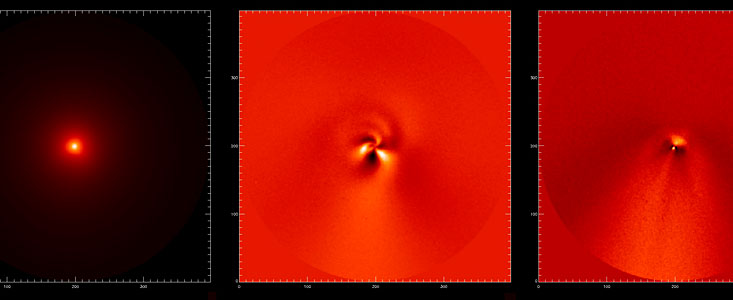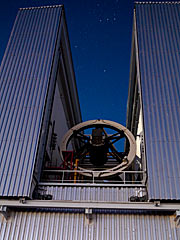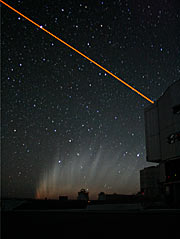Press Release
The Celestial Whirligig
Unique Observations of Comet McNaught Reveal Sprinkling Nucleus
23 February 2007
Comet McNaught, the Great Comet of 2007, has been delighting those who have seen it with the unaided eye as a spectacular display in the evening sky. Pushing ESO's New Technology Telescope to its limits, a team of European astronomers have obtained the first, and possibly unique, detailed observations of this object. Their images show spectacular jets of gas from the comet spiralling several thousands of kilometres into space, while the spectra reveal the presence of sodium in its atmosphere, something seen very rarely.
Comet C/2006 P1 (McNaught) has rightly earned the title of a 'Great Comet' - one so bright in the sky that such an occurrence could be expected just once in a generation.
The problem for astronomers was that the comet stayed very close to the Sun and so was only visible very low on the horizon, making it impossible for most professional telescopes to study it in detail. One telescope, however, was up to the challenge: ESO's New Technology Telescope (NTT), at La Silla.
"We had previously pointed the NTT very low to observe the planet Mercury, which is very close to the Sun and is therefore only visible low in the sky just after sunset. I realised that we could take advantage of the same low pointing limit to observe the comet while it was near the Sun", said ESO astronomer Colin Snodgrass [1].
From the 29th January onwards, the comet was thus observed with the NTT, revealing in detail the heart of the comet. This was no easy feat as even with the NTT it was only observable for half an hour after sunset. Luckily, the NTT has another major advantage: it is equipped with the versatile ESO Multi Mode Instrument (EMMI), which can provide both imaging and spectroscopic observations across the visible wavelength range. This meant that the maximum amount of scientific data could be taken during the limited time available for observations.
The unique images reveal three clear jets of gas, which are seen to spiral away from the nucleus as it rotates, like a Catherine Wheel firework.
"These jets are produced when sunlight heats ices on the surface of the comet, causing them to evaporate into space and create 'geyser' like jets of gas and small dust particles, which stretch over 13,000 km into space - greater than the diameter of the Earth - despite the fact that the nucleus of the comet is probably less than 25 km in diameter," explained Snodgrass.
By comparing images like this taken at different times, astronomers should be able to calculate how fast the nucleus rotates from the changing pattern of jets.
Other images also reveal that while the gas forms spiral jets, the large dust particles released from the comet follow a different pattern, as they are thrown off the comet's surface on the brightly lit side towards the Sun, producing a bright fan, which is then blown back by the pressure of sunlight itself.
As well as taking images, the astronomers were able to investigate which gases were present in the comet's atmosphere [2] using spectroscopy. The usual gaseous species have been detected, such as cyanide, carbon, and ammonia, whose analysis will help the astronomers to determine the activity level of the comet and its chemical type.
But already in the first high resolution spectrum obtained on 29 January, the astronomers noted something quite unusual.
"We detected two very bright lines - the brightest of the whole spectrum taken on this day as a matter of fact - close to 589 nm and quickly identified them as belonging to neutral sodium atoms," said Emmanuël Jehin (ESO). "Further measurements showed this sodium emission to be extending over more than 100,000 km in the tail direction and fading rapidly with time."
Such lines have only been detected in the greatest comets of the past century like C/Ikeya-Seki in 1965, C/West in 1976 and C/Hale-Bopp in 1997, for which a very narrow sodium tail was even photographed. This straight neutral tail appears in addition to the dust and ionised gas tails when the comet is close to the Sun.
"Its origin lies most probably in the dissociation of the cometary dust grains," said Jehin. "In very active comets, which are also usually the ones which pass closer to the Sun, the dust grains are vaporised under the intense heat and start releasing sodium atoms which then react to the solar radiation and emit light—at the very same yellow-orange wavelength of the lamps on our streets."
Sodium has also been observed around Mercury and the Moon forming a very tenuous atmosphere. But closer to us, at 90 km altitude in our atmosphere, there is the so-called 'sodium layer'. The origin of that layer is not well known but might be coming from the ablation of meteoroids that are burning (due to their high entry speed in the atmosphere) at the same altitude. As most shooting stars (or meteors) originate from comets (annual showers like the Eta Aquarids and Orionids originate from comet P/Halley, the Leonids come from comet P/Tempel-Tuttle, and the Perseids from comet P/Swift-Tuttle), the sodium in those dust particles might just be the same. As a kind of gift to the astronomers that layer is used by observatories like Paranal to produce with a laser an artificial star that allows for the correction of atmospheric turbulence!
Contacts
Colin Snodgrass
ESO
Chile
Tel: +56 2 463 3069
Email: csnodgra@eso.org
Emmanuël Jehin
ESO
Chile
Tel: +56 2 463 3054
Email: ejehin@eso.org
About the Release
| Release No.: | eso0707 |
| Legacy ID: | PR 07/07 |
| Name: | Comet McNaught |
| Type: | Solar System : Interplanetary Body : Comet : Coma |
| Facility: | New Technology Telescope |
| Instruments: | EMMI |
Our use of Cookies
We use cookies that are essential for accessing our websites and using our services. We also use cookies to analyse, measure and improve our websites’ performance, to enable content sharing via social media and to display media content hosted on third-party platforms.
ESO Cookies Policy
The European Organisation for Astronomical Research in the Southern Hemisphere (ESO) is the pre-eminent intergovernmental science and technology organisation in astronomy. It carries out an ambitious programme focused on the design, construction and operation of powerful ground-based observing facilities for astronomy.
This Cookies Policy is intended to provide clarity by outlining the cookies used on the ESO public websites, their functions, the options you have for controlling them, and the ways you can contact us for additional details.
What are cookies?
Cookies are small pieces of data stored on your device by websites you visit. They serve various purposes, such as remembering login credentials and preferences and enhance your browsing experience.
Categories of cookies we use
Essential cookies (always active): These cookies are strictly necessary for the proper functioning of our website. Without these cookies, the website cannot operate correctly, and certain services, such as logging in or accessing secure areas, may not be available; because they are essential for the website’s operation, they cannot be disabled.
Functional Cookies: These cookies enhance your browsing experience by enabling additional features and personalization, such as remembering your preferences and settings. While not strictly necessary for the website to function, they improve usability and convenience; these cookies are only placed if you provide your consent.
Analytics cookies: These cookies collect information about how visitors interact with our website, such as which pages are visited most often and how users navigate the site. This data helps us improve website performance, optimize content, and enhance the user experience; these cookies are only placed if you provide your consent. We use the following analytics cookies.
Matomo Cookies:
This website uses Matomo (formerly Piwik), an open source software which enables the statistical analysis of website visits. Matomo uses cookies (text files) which are saved on your computer and which allow us to analyze how you use our website. The website user information generated by the cookies will only be saved on the servers of our IT Department. We use this information to analyze www.eso.org visits and to prepare reports on website activities. These data will not be disclosed to third parties.
On behalf of ESO, Matomo will use this information for the purpose of evaluating your use of the website, compiling reports on website activity and providing other services relating to website activity and internet usage.
Matomo cookies settings:
Additional Third-party cookies on ESO websites: some of our pages display content from external providers, e.g. YouTube.
Such third-party services are outside of ESO control and may, at any time, change their terms of service, use of cookies, etc.
YouTube: Some videos on the ESO website are embedded from ESO’s official YouTube channel. We have enabled YouTube’s privacy-enhanced mode, meaning that no cookies are set unless the user actively clicks on the video to play it. Additionally, in this mode, YouTube does not store any personally identifiable cookie data for embedded video playbacks. For more details, please refer to YouTube’s embedding videos information page.
Cookies can also be classified based on the following elements.
Regarding the domain, there are:
- First-party cookies, set by the website you are currently visiting. They are stored by the same domain that you are browsing and are used to enhance your experience on that site;
- Third-party cookies, set by a domain other than the one you are currently visiting.
As for their duration, cookies can be:
- Browser-session cookies, which are deleted when the user closes the browser;
- Stored cookies, which stay on the user's device for a predetermined period of time.
How to manage cookies
Cookie settings: You can modify your cookie choices for the ESO webpages at any time by clicking on the link Cookie settings at the bottom of any page.
In your browser: If you wish to delete cookies or instruct your browser to delete or block cookies by default, please visit the help pages of your browser:
Please be aware that if you delete or decline cookies, certain functionalities of our website may be not be available and your browsing experience may be affected.
You can set most browsers to prevent any cookies being placed on your device, but you may then have to manually adjust some preferences every time you visit a site/page. And some services and functionalities may not work properly at all (e.g. profile logging-in, shop check out).
Updates to the ESO Cookies Policy
The ESO Cookies Policy may be subject to future updates, which will be made available on this page.
Additional information
For any queries related to cookies, please contact: pdprATesoDOTorg.
As ESO public webpages are managed by our Department of Communication, your questions will be dealt with the support of the said Department.




